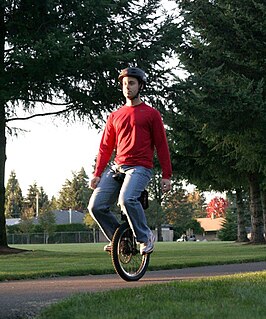
The Segway is a two-wheeled, self-balancing personal transporter invented by Dean Kamen and brought to market in 2001 as the Segway HT, subsequently as the Segway PT, and manufactured by Segway Inc. HT is an initialism for "human transporter" and PT for "personal transporter."

A unicycle is a vehicle that touches the ground with only one wheel. The most common variation has a frame with a saddle, and has a pedal-driven direct drive. A two speed hub is commercially available for faster unicycling. Unicycling is practiced professionally in circuses, by street performers, in festivals, and as a hobby. Unicycles have also been used to create new sports such as unicycle hockey. In recent years, unicycles have also been used in mountain unicycling, an activity similar to mountain biking or trials.

An electric unicycle is a self-balancing personal transporter with a single wheel. The rider controls speed by leaning forwards or backwards, and steers by leaning and twisting the unit side to side. The self-balancing mechanism uses gyroscopes and accelerometers. In 2020, suspension models were introduced by three major manufacturers Begode, Kingsong and Inmotion

A gyrocar is a two-wheeled automobile. The difference between a bicycle or motorcycle and a gyrocar is that in a bike, dynamic balance is provided by the rider, and in some cases by the geometry and mass distribution of the bike itself, and the gyroscopic effects from the wheels. Steering a motorcycle is done by precessing the front wheel. In a gyrocar, balance was provided by one or more gyroscopes, and in one example, connected to two pendulums by a rack and pinion.

A monowheel, or uniwheel, is a one-wheeled single-track vehicle similar to a unicycle. Instead of sitting above the wheel as in a unicycle, the rider sits either within the wheel or next to it. The wheel is a ring, usually driven by smaller wheels pressing against its inner rim. Most are single-passenger vehicles, though multi-passenger models have been built.

A dicycle is a vehicle with two parallel wheels, side by side, unlike single-track vehicles such as motorcycles and bicycles, which have two wheels inline. Originally used to refer to devices with large wheels and pedals, the term is now used in relation to powered self-balancing scooters with smaller wheels and no pedals such as the Segway PT and the self-balancing hoverboard.
State Route 500 (SR 500) is a state highway in Clark County, Washington, United States. The east–west highway runs through Vancouver as an expressway and its eastern suburbs as a country road, connecting Interstate 5 (I-5) to I-205 in eastern Vancouver and SR 14 in Camas. SR 500 runs concurrent to SR 503 within Orchards and also uses a section of the county-built Padden Parkway.

The Uno is a novel self-balancing electric motorcycle using two wheels side by side. The Uno III adds a third wheel that allows it to transform into a tricycle.

Ben Gulak is a Ukrainian Canadian inventor best known for creating the Uno, an eco-friendly, electric-powered vehicle that bears a resemblance to a motorized unicycle. The vehicle had its first public unveiling in 2008, and was awarded a Top-10 prize on Popular Science's list of 2008 Invention Awards. Gulak founded the Massachusetts-based company BPG Motors, which has also developed a design for the DTV Shredder, a portable all-terrain vehicle with the handlebars of a Segway and treads similar to those of a tank.

The Personal Urban Mobility and Accessibility (PUMA) was an experimental electrically powered road vehicle created by Segway and adopted by General Motors as a concept vehicle representing the future of urban transportation. It operates on two wheels placed side by side, a layout that differs in placement from motorcycles which instead have their two wheels placed at the front and rear.
The Honda U3-X is an experimental self-balancing one-wheeled personal transporter shown in 2009.

The Aerial Reconfigurable Embedded System (ARES) was a concept for an unmanned VTOL flight module that can transport various payloads. The concept started as the TX (Transformer) in 2009 for a terrain-independent transportation system centered on a ground vehicle that could be configured into a VTOL air vehicle and carry four troops. ARES' primary function was the same as TX, to use flight to avoid ground-based transportation threats like ambushes and IEDs for units that don't have helicopters for those missions. It was to be powered by twin tilting ducted fans and have its own power system, fuel, digital flight controls, and remote command-and-control interfaces. The flight module would have different detachable mission modules for specific purposes including cargo delivery, CASEVAC, and ISR. Up to 3,000 lb (1,400 kg) of payload would be carried by a module.

Segway Inc. is an American manufacturer of two-wheeled personal transporters, chiefly through its Segway PT and Segway miniPro product lines. Founded by inventor Dean Kamen in 1999, the company's name is a homophone of the word "segue".
Robstep is a line of two-wheeled, self-balancing, battery-powered electric vehicles invented by Dongguan Robstep Robot Co., Ltd. of Guangdong, Dongguan, China. The name "Robstep" is a portmanteau of the words "robot" and "step", meaning robotic steps. The devices have been compared to Segways.

Daniel Wood is an American inventor and entrepreneur, best known for creating the first commercially available self-balancing unicycle. He is currently the founder and CEO of Focus Designs. He is also the Director of Control Systems at Future Motion as well as an advisory council member at RYNO Motors.
The Inmotion SCV is a series of self-balancing, sensor controlled, battery-powered dicycles and electric unicycles from Inmotion Technologies of Shenzhen, China.

A self-balancing scooter is a self-balancing personal transporter consisting of two motorized wheels connected to a pair of articulated pads on which the rider places their feet. The rider controls the speed by leaning forwards or backwards, and direction of travel by twisting the pads.

Shane Chen is a Chinese-American inventor and entrepreneur based in Camas, WA USA. He is best known for inventing the self-balancing hoverboard.

A personal transporter is a class of compact, mostly recent, motorised micromobility vehicle for transporting an individual at speeds that do not normally exceed 25 km/h (16 mph). They include electric skateboards, kick scooters, self-balancing unicycles and Segways, as well as gasoline-fueled motorised scooters or skateboards, typically using two-stroke engines of less than 49 cc (3.0 cu in) displacement. Many newer versions use recent advances in vehicle battery and motor-control technologies. They are growing in popularity, and legislators are in the process of determining how these devices should be classified, regulated and accommodated during a period of rapid innovation.

Micromobility refers to a range of small, lightweight vehicles operating at speeds typically below 25 km/h (15 mph) and driven by users personally. Micromobility devices include bicycles, e-bikes, electric scooters, electric skateboards, shared bicycles, and electric pedal assisted (pedelec) bicycles.

















